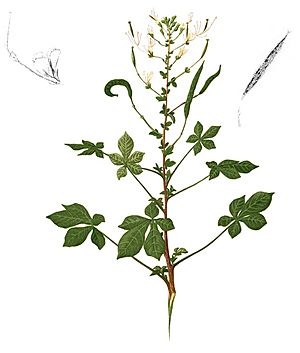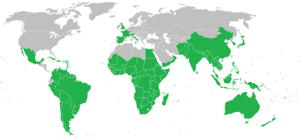Cleome gynandra facts for kids
Quick facts for kids Cleome gynandra |
|
|---|---|
 |
|
| Scientific classification | |
| Genus: |
Cleome
|
| Species: |
gynandra
|
 |
|
| world range | |
| Synonyms | |
|
|
Cleome gynandra is a type of plant often eaten as a green vegetable. It's known by many fun names like Shona cabbage, African cabbage, spiderwisp, cat's whiskers, and even stinkweed. This plant is an annual wildflower, meaning it grows and dies within one year.
It originally comes from Africa. However, it has spread and now grows in many tropical and sub-tropical parts of the world. It's an upright plant with branches, usually growing between 25 cm and 60 cm tall. Its leaves are made up of 3 to 5 oval-shaped smaller leaves. The flowers are white, but they can turn a pretty rose pink as they get older. The seeds are tiny brown spheres, about 1.5 mm wide. Both the leaves and flowers are safe to eat. The leaves have a strong, sometimes peppery taste, a bit like mustard greens.
Contents
Eating and Using Cleome gynandra
People often cook the leaves and young shoots of this plant. They are usually boiled or added to stews. In places like Sub-Saharan Africa, people often dry the leaves to store them. Later, they cook them with milk or butter to make them less bitter. In Uganda and Tanzania, the leaves are cooked with a paste made from groundnuts.
This plant is also helpful for farmers. It can be grown between other crops because it helps keep insects away.
In Thailand, people enjoy the leaves fermented with rice water. This makes a pickle called phak sian dong. A similar pickle is eaten in northern Malaysia, where it's known as jeruk maman.
Healthy Benefits of Cleome gynandra
Cleome gynandra is a very healthy vegetable. It has lots of important nutrients. These include beta-carotene, folic acid, ascorbic acid (which is Vitamin C), and calcium. It also contains vitamin E, iron, and oxalic acid. About 4% of the leaves are protein. The leaves also have special properties that can help reduce swelling in the body. Because of these anti-inflammatory properties, it is sometimes used as a traditional medicine.
Different Names Around the World
Cleome gynandra is known by many different names. These names change depending on the language and where you are in the world.
Names in Africa
In Africa, people often call it spinach or wild spinach. But it's not the same as the spinach you might usually eat! Here are some names in local languages:
- munyevhe in Shona
- murudi in Venda
- ulude in Zulu
- ombidi or omboga in Ovambo
- echadoi in Teso
- jobyo or ejobyo in Luganda
- eshogi in Runyankore
- chinsaga in Gusii
- dek in Luo
- etchilachaou in Nuni
- mgagani in Swahili
Names in Asia
In Asia, this plant also has many names:
- shwetahudhude in Bengali
- tilavan in Marathi
- vaminta or vayinta in Telugu
- phak sian in Thai
- maman in Malay
- màn màn trắng or màn ri trắng in Vietnamese
Names in Europe
In Europe, it's known by these names:
Where Cleome gynandra Grows
This plant is an annual wildflower that started in Africa. But it has spread naturally to tropical and sub-tropical areas across Asia. It grows best in soil that has been disturbed and drains water well. It can also handle dry conditions. However, it doesn't like cold weather and can be damaged by frost.
In some parts of the U.S. and other Pacific regions, Cleome gynandra is seen as an invasive weed. This means it grows quickly and can take over areas, sometimes harming local plants.
See also
 In Spanish: Cleome gynandra para niños
In Spanish: Cleome gynandra para niños


